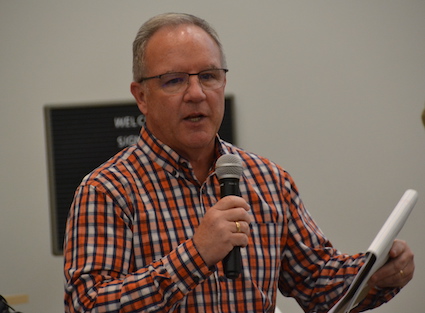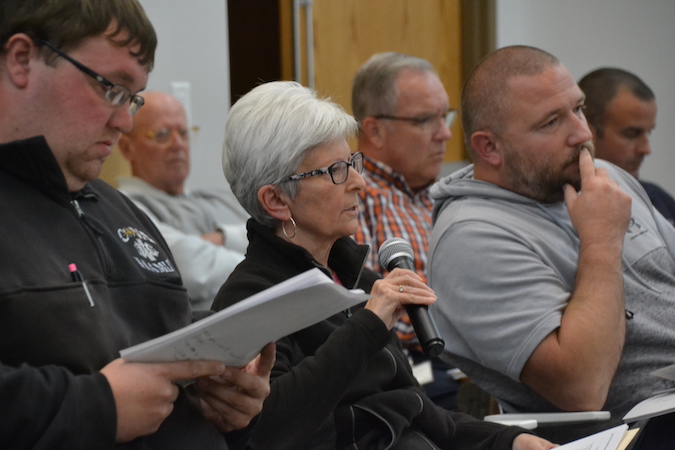If COVA closes, Monroe Ambulance says it could cover central Orleans
ALBION – Monroe Ambulance, which is the primary ambulance provider in eastern Orleans County, said it could serve central Orleans County if COVA closes.
John Caufield, chief operating officer for Monroe Ambulance, spoke during an EMS Task Force meeting on Thursday. Those meetings have been going on since February.
Caufield said Monroe wasn’t trying to knock out COVA, but Monroe could expand into central Orleans. If that happened, Monroe would serve a block of seven Orleans towns – Barre, Albion, Gaines and Carlton in the central part and Clarendon, Murray and Kendall on the east side.

John Caufield, chief operating officer for Monroe Ambulance, says Monroe would likely keep two ambulances in Orleans, and maybe three if it served a block of seven towns.
“We see value in the consortium of seven towns,” Caufield said. “There is an opportunity for better service if we serve the area as a block of seven towns.”
Monroe would likely have two ambulances stationed in the county – one in Albion and the other likely in Holley or Kendall – and possibly a third when there is a higher call volume. Monroe also could draw from ambulances it has based in Brockport and Greece if there was higher demand in Orleans, Caufield said.
Monroe has 26 ambulances and six fly cars for northwest Monroe County, eastern Orleans and Wyoming County. Monroe currently doesn’t base in ambulance in Orleans because the call volume in eastern Orleans – about 1,200 calls a year – doesn’t financially justify keeping in ambulance on the east side, Caufield said.
But including central Orleans, where he said there are about 2,200 ambulance calls annually, would be enough for Monroe to likely dedicate two ambulances throughout the day, with a third during peak call volumes.
Monroe would also have a supervisor and dedicated crews for Orleans if Monroe became the primary provider for the seven towns, Caufield said.
COVA has been the central Orleans provider for 43 years. The agency is in a financial crisis and has been seeking support from the four central towns, either with a contract or in a taxing district.
Anna Tower, the COVA treasurer, said COVA needs $150,000 to $200,000 annually from the towns to cover a deficit. COVA used to make a profit each year and the extra funds would go towards purchasing a new ambulance.
But COVA has been operating a deficit in recent years – $161,000 in 2019 and $172,000 in 2020. The agency received federal PPP funds in 2021 to stay about even that year, Tower said. But this year has been another deficit. COVA has used up its reserves and accumulated $70,000 in unpaid bills, while struggling to make payroll. The organization has cut expenses by $40,000 to try to stay open.
Tower said a big factor in COVA’s profitability has been an increase in patients on Medicare and Medicaid, which offers COVA a low reimbursement. A decade ago, about 60 percent of patients were on Medicaid or Medicare with others on private insurance that pays at a higher rate. About 85 to 89 percent of patients are now Medicare or Medicaid, Tower said, and those rates don’t cover COVA’s costs.
“We are definitely in trouble,” she said at the EMS Task Force meeting. “”We need the help from the towns and possibly the village.”
The four towns have met with COVA but haven’t reached an agreement on how much to give them. County legislators John Fitzak and Skip Draper said COVA’s numbers have shifted, creating some uneasiness among the town leaders.
Fitzak said last month COVA leaders were seeking a $13,000 a month subsidy. But on Wednesday, in a meeting with the Albion Village Board, COVA said it would need a $16,000 subsidy.
The Village Board is considering the $16,000 a month to have a COVA ambulance primarily dedicated to the village.
Fitzak and Draper also said COVA has presented the deficit as about $150,000 a year, but in a presentation last month, a COVA official sought $50 per household from central Orleans that would be about $379,000 a year.
“You have to have a good handle on your business before we can figure out how to help you,” Draper said during the task force meeting.
Fitzak also said COVA and the four towns need to have a metric that is fair for covering the subsidy, whether by assessed value in each town or call volume per municipality to determine how much each of the four towns would contribute. Or maybe the four just evenly split the cost.
Tower, the COVA treasurer, said the organization would provide a precise number.
Ultimately, Draper said the issue needs to be worked out between the four towns and COVA. The four town supervisors also met with Monroe Ambulance last week to discuss ambulance service in the four towns.
Caufield said Monroe could step in but it would need some time to ramp up its service in the county. Monroe currently doesn’t get a municipal stipend in its service area and is funded as a billed service.
He acknowledged it is a challenging business to provide ambulance service. He said there are 25 fewer ambulances in Monroe County compared to eight years ago and 10 fewer agencies.
“The economic model is upside down,” he said.
Richard Remley, the Albion town supervisor, said he expects more clarity in the next month on ambulance service in central Orleans.
The EMS Task Force next meets on Nov. 10.






































































